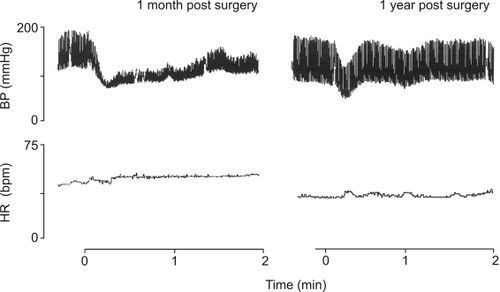Orthostatic hypotension due to arterial baroreflex failure
H.J.L.M. Timmers*, W. Wieling §, J.M. Karemaker +, J.W.M. Lenders *. Department of Medicine, Radboud University Nijmegen Medical Centre, Nijmegen * and Department of Medicine § and Physiology + Academic Medical Centre University of Amsterdam, Amsterdam (The Netherlands)
Case Report
A 63-year-old female, had undergone radical excision of a right sided carotid body tumor at the age of 23. Forty years later, a contralateral carotid body tumor was resected. Surgery was radical and no malignancy was found. The second operation was followed by severe, disabling postural lightheadedness and near-syncope. In addition she suffered from attacks of seve¬re heada¬che, evoked by mental stress and physical exercise like cycling. She had also developed dysphagia and voice changes. Impairment of rima glottis closure at laryngoscopy indicated damage to the superior laryn¬geal nerve.
Since bilateral carotid body tumor surgery can be complicated by arterial baroreflex failure due to damage to the carotid sinus baroreceptors [1], pre- and post surgical baroreflex control of blood pressure were documented. Mean office blood pressure was 177/98 mmHg before the second operation as compared to 194/116 mmHg one year after surgery. Ambulant blood pressure variability during scheduled stand¬ar¬dized activi¬ties was assessed by means of a 24 hours beat-to-beat recording of finger arterial pressure using the Por¬tapres device (model 1, TNO-BioMe¬dical In¬strumentation, Amster¬dam, The Nether¬lands) [2]. One year following surgery, blood pressure variability had increased as compared to the pre-surgical state. After the operation 75% of mean arterial blood pressure values were found between 66 to 110 mm Hg, while 75% of blood pressure values occurred between 69 to 97 mm Hg before the operation. Marked blood pressures increments were observed during activities like walking (from 111/66 to 160/79 mm Hg) and cycling (from 139/68 to 160/80 mm Hg). During mental activity like watching television or telephone conversation blood pressure rose to values between 192/96 and 232/123 mm Hg.
In addition, because of severe orthostatic symptoms, orthostatic control of blood pressure was evaluated. Before surgery, active standing resulted in a decrease from 150/80 mmHg (supine) to 135/65 mmHg (1 minute standing). One month after surgery, there was an initial decrease in blood pressure of 170/110 to 90/75 mmHg with a sluggish, inadequate recovery (Figure 1 left). The maximal initial increase in heart rate was abnormally low (+ 5 bpm, normal >13 bpm). In addition, Valsalva’s manoeuvre showed a progressive decrease in blood pressure during straining without a blood pressure overshoot after release of the strain. Heart rate did not change during this procedure. At 1 year follow-up, the initial blood pressure decrease during active standing was still marked (55/35 mm Hg, normal < 40/25), but overt orthostatic hypotension had resolved (Figure 1 right).
Editor's Comment
The acute form of baroreflex failure is encountered following loss of glossopharyngeal or carotid sinus nerve function due to surgical intervention or accidental injury [1][3][4]. It is characterized by severe, unremitting hypertension, tachycardia, and headache. The systolic blood pressure can exceed 250 mmHg, which may lead to hypertensive encephalopathy and (fatal) cerebral haemorrhage [5]. Hypertensive crisis may evolve over days and weeks into the more chronic volatile hypertensive phase [1][6]. In addition, volatile hypertension may result from a gradual decline in baroreflex function due to neck irradiation [7]. Volatile hypertension due to baroreflex failure is characterized by paroxysms of abrupt sympathetic activation, including excessive increments in plasma catecholamine levels. Surges of blood pressure and tachycardia may occur spontaneously or are elicited by mental stress or physical stimuli like exercise, cold and sexual arousal. These bouts of sympathetic activation may be accompanied by severe headaches, palpitations, diaphoresis, lightheadedness and anxiety. In addition, emotional instability appears to be a prominent feature in this phase of baroreflex failure.
Apart from hypertensive surges, hypotensive episodes may occur during sleep. In rare cases, inadequate baroreflex buffering of cardiovagal efference is the most prominent feature, resulting in malignant vagotonia with hypotension, bradycardia, and asystole [8]. Accompanying symptoms of this so-called “selective baroreflex failure” include fatigue and dizziness, with possible progression to frank syncope. In the patient presented here, orthostatic lightheadedness due to initial orthostatic dizziness and orthostatic hypotension was a prominent feature of baroreflex failure. Orthostatic hypotension was originally claimed not to be part of the baroreflex failure syndrome [1]. However, compensatory mechanisms were later shown to fail after squatting [7]. In other cases, orthostatic hypotension may not become apparent until years after baroreceptor denervation [9]. In addition, persistent orthostatic hypotension was found in patients after bilateral carotid body tumor surgery [10]. Afferent baroreceptor denervation in these patients was shown to result in abnormal control of cardiovagal efference and as well as of efferent muscle sympathetic nerve activity [11]. Abnormal orthostatic control of blood pressure and heart rate following lesion of afferent baroreceptors may occur through abnormal baroreflex-mediated adjustments of both efferent pathways during active standing. In the patient presented here, orthostatic hypotension resolved within 1 year after the onset of baroreflex failure, whereas initial orthostatic dizziness and hypotension persisted. Remaining aortic baroreceptors, as well as cardiopulmonary baroreceptors may in time (partially) compensate for the loss of carotid sinus baroreceptors.
References
Error fetching PMID 9488236:
Error fetching PMID 7886730:
Error fetching PMID 12034659:
Error fetching PMID 13396428:
Error fetching PMID 11901044:
Error fetching PMID 10638805:
Error fetching PMID 9369258:
Error fetching PMID 12640254:
Error fetching PMID 12810758:
- Error fetching PMID 8413455:
- Error fetching PMID 9488236:
- Error fetching PMID 7886730:
- Error fetching PMID 12034659:
- Error fetching PMID 13396428:
- Error fetching PMID 11901044:
- Error fetching PMID 10638805:
- Error fetching PMID 9369258:
-
Robertson RM. Baroreflex failure. In: Robertson D, Low PA, Polinsky J, editors. Primer on the autonomic nervous system. London: Academis Press Limited; 1996. p. 197-208.
- Error fetching PMID 12640254:
- Error fetching PMID 12810758:
